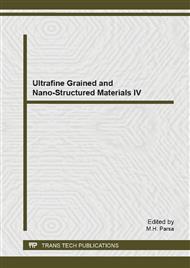[1]
M.H. Huang, S. Mao, H. Feick, H. Yan, Y. Wu, H. Kind,.. & P. Yang, Room-temperature ultraviolet nanowire nanolasers, Science 292. 5523 (2001) 1897-1899.
DOI: 10.1126/science.1060367
Google Scholar
[2]
M. Law, L.E. Greene, J.C. Johnson, R. Saykally & P. Yang, Nanowire dye-sensitized solar cells, Nat. Mater. 4. 6 (2005) 455-459.
DOI: 10.1038/nmat1387
Google Scholar
[3]
B. Shouli, C. Liangyuan, L. Dianqing, Y. Wensheng, Y. Pengcheng, L. Zhiyong, .. & C.C. Liu, Different morphologies of ZnO nanorods and their sensing property, Sensor. Actuat. B-Chem. 146. 1 (2010) 129-137.
DOI: 10.1016/j.snb.2010.02.011
Google Scholar
[4]
M. Cristina Yeber, J. Rodrı́guez, J. Freer, N. Durán, & H. D Mansilla, Photocatalytic degradation of cellulose bleaching effluent by supported TiO2 and ZnO, Chemosohere 41. 8 (2000) 1193-1197.
DOI: 10.1016/s0045-6535(99)00551-2
Google Scholar
[5]
P. X. Gao & Z. L. Wang, High‐Yield Synthesis of Single‐Crystal Nanosprings of ZnO, Small 1. 10 (2005) 945-949.
DOI: 10.1002/smll.200500165
Google Scholar
[6]
Z. Zhang, H. Yuan, J. Zhou, D. Liu, S. Luo, Y. Miao, .. & S. Xie, Growth mechanism, photoluminescence, and field-emission properties of ZnO nanoneedle arrays, J. Phys. Chem. B 110. 17 (2006) 8566-8569.
DOI: 10.1021/jp0568632
Google Scholar
[7]
M. Kawakami, A.B. Hartanto, Y. Nakata, & T. Okada, Synthesis of ZnO nanorods by nanoparticle assisted pulsed-laser deposition, Jpn. J. Appl. Phys. 42 (2003) 33.
DOI: 10.1143/jjap.42.l33
Google Scholar
[8]
Q. Li, V. Kumar, Y. Li, H. Zhang, T.J. Marks & R.P. Chang, Fabrication of ZnO nanorods and nanotubes in aqueous solutions, Chem. Mater. 17. 5 (2005) 1001-1006.
DOI: 10.1021/cm048144q
Google Scholar
[9]
X. Wu, H. Bai, C. Li, G. Lu & G. Shi, Controlled one-step fabrication of highly oriented ZnO nanoneedle/nanorods arrays at near room temperature, Chem. Commun. 15 (2006) 1655-1657.
DOI: 10.1039/b516497d
Google Scholar
[10]
D. Wang & C. Song, Controllable synthesis of ZnO nanorod and prism arrays in a large area. J. Phys. Chem. B 109. 26 (2005) 12697-12700.
DOI: 10.1021/jp0506134
Google Scholar
[11]
Powder Diffraction File, Joint Committee on Powder Diffraction Standards, ICDD, Swarthmore, PA, 1996, Card 36–1451(ZnO).
Google Scholar
[12]
J. Lu, Z. Ye, J. Huang, L. Wang & B. Zhao, Synthesis and properties of ZnO films with (1 0 0) orientation by SS-CVD, Appl. Surf. Sci. 207. 1 (2003) 295-299.
DOI: 10.1016/s0169-4332(02)01502-7
Google Scholar


